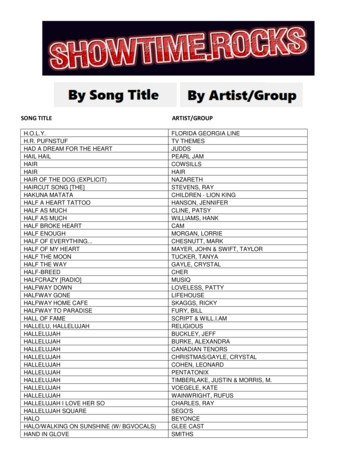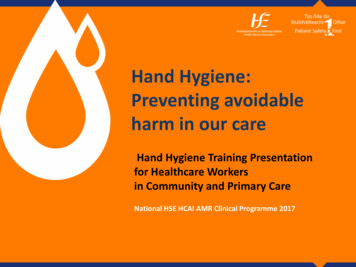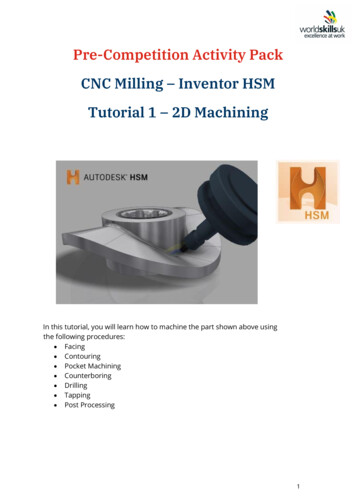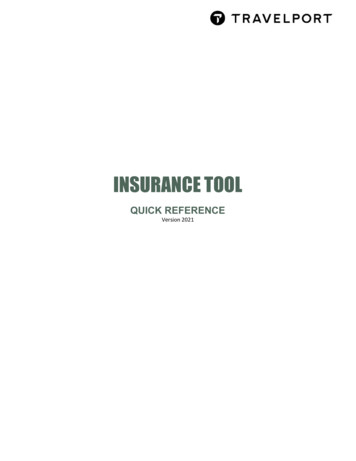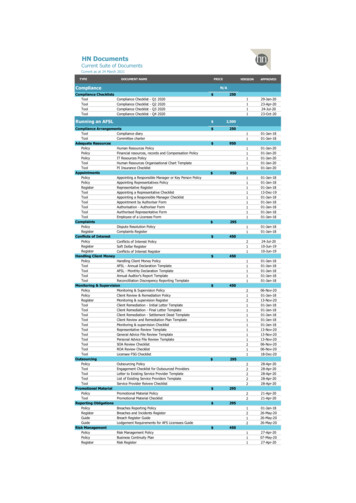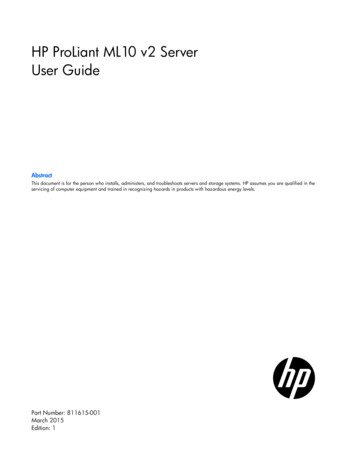
Transcription
HAND AND PORTABLEPOWER TOOLSAFETY GUIDELINESPURPOSEThe purpose of this guidance document is to promote the safe use of, and to reduce the likelihoodof injuries involving hand or power tools.SCOPEThese requirements apply to all University departments and their employees where the use ofhand or power tools are in use or will be used. This will most notably apply to employeesinvolved in industrial, maintenance, construction and manual labor trade areas.RESPONSIBILITIESEnvironmental Health and Safety: EHS is responsible for reviewing hazards associated withhand and portable power tools during annual shop inspections. The tools will be reviewed tomake sure they are in good working order, suitable for the jobs they are used for, and do not posea hazard to the operator. EHS is responsible for reviewing and updating the Hand & PortablePower Tools Guidelines. EHS and supervisors can also work jointly in the development of JobSafety Analysis for hand tools that present a unique hazard to the employee.Supervisor and Employee: Supervisor led training is required upon employment for employeeswho operate hand and portable power tools. Select the Right Tool for the Job: Examples of unsafe practices are: Strikinghardened faces of hand tools together (such as using a carpenter's hammer to strikeanother hammer, hatchet, or metal chisel), using a file for a pry, a wrench for ahammer, using a ‘cheater’, and pliers instead of the proper wrench. Keep Tools in Good Working Condition: Wrenches with cracked work jaws, screwdrivers with broken points or broken handles, hammers with loose heads, dull saws,and extension cords or electric tools with broken plugs, improper or removedgrounding prongs, or split insulation are examples of tools in poor conditions. Toolsthat have deteriorated in this manner must be taken out of service. Use Tools the Right Way: Screw drivers applied to objects held in the hand, knivespulled toward the body, and failure to ground electrical equipment are commoncauses of accidents. Place/Keep/Store Tools in a Safe & Secure Place: Many accidents have beencaused by tools falling from overhead and by knives, chisels, and other sharp toolsHand and Power Tool Guidelines GS-91Page 1
carried in pockets or left in tool boxes with cutting edges exposed. Tools should bekept away from work bench edges.The following procedures are excellent shop practices for supervisors and employees to followin order to promote a safe working environment where hand and portable power tools are used: Establish regular tool inspection procedures and provide good repair facilities to ensurethat tools will be maintained in safe condition. Establish a procedure for control of tools such as a check-out system at tool cribs. Provide proper storage facilities in the tool room and on the job. The employer is responsible for the safe condition of tools and equipment used byemployees, but the employees have the responsibility for properly using and maintainingtools.**Failure to observe safe work practices when using hand and portable power tools accountsfor most hand and power tool accidents.Each supervisor is to make a complete check of his/her operations to determine the need forspecial tools that will do the work more safely than ordinary tools. This can be completed bydeveloping a Job Safety Analysis which can be used to identify the hazards associated with thejob and the appropriate tools that should be used.Special tools should be kept readily available in a centralized tool room if possible.The tool room attendant or craft supervisor should be qualified through training and experienceto pass judgment on the condition of tools for further use. Dull or damaged tools shall not bereturned to stock.Employees shall not continue use of damaged tools during a job if it is noticed during the job thatthe tool is damaged.Proper maintenance and repair of tools requires adequate facilities, work benches, vises, a forgeor furnace for hardening and tempering, tempering baths, safety goggles, repair tools, grinders,and good lighting. Employees specifically trained in the care of tools should be in charge ofthese facilities. If this service is not available, tools should be sent out for repairs.CARRYING TOOLSEmployees are prohibited from carrying tools, which in any way could interfere with using bothhands freely on a ladder or while climbing on a structure. A strong bag, bucket, or similarcontainer is to be used to hoist tools from the ground to the job. Tools are to be returned in thesame manner. Employees should never bring tools down by hand, carry in pant/shirt pockets, ordropped tools to the ground.Loose tools and tools laid inappropriately cause a substantial portion of hand tool injuries.Tools should not be left above where employees are moving or walking. This presents a fallingobject hazard.Hand and Power Tool Guidelines GS-91Page 2
Chisels, screwdrivers, and pointed tools shall never be carried in an employee's pocket. They areto be carried in a tool box/cart, a carrying belt (sharp/pointed end down) like those used byelectricians and steel employees, a pocket tool pouch, or in the hand with points and cuttingedges pointed away from the body.Employees carrying tools on their shoulders should pay close attention to clearances whenturning around. Tools should also be handled so that they will not strike other employees orpedestrians.PERSONAL PROTECTIVE EQUIPMENTAppropriate personal protective equipment (i.e.: safetyglasses, face shield, safety goggles, gloves, etc.) should beworn to protect from hazards that may be encounteredwhile using portable power tools and hand tools.Face ShieldSafety GlassesEmployees that use hand and power tools and are exposed to the hazards of falling, flying,abrasive and splashing materials, or exposed to harmful dusts, fumes, vapors, or gases shall beprovided with the specified personal protective equipment necessary to protect them from thehazard.USE OF HAND TOOLSHand tools are non-powered, which includes axes, wrenches, screw drivers, hammers, etc. Thegreatest hazards posed by hand tools results from misuse and improper maintenance.Employee instruction/training programs shall provide detailed training in the proper use of handtools for the specific area of operations in which they will be working in. Attention will be givento tool selection, tool use, and proper personal protective equipment that are required to be usedwhen operating the specific tool as outlined in the following sections:Metal-Cutting Hand ToolsChisels Factors determining the selection of cold chiselsare the materials to be cut, the size and shape ofthe tool, and the depth of the cut to be made.Various MetalCutting Chisels The chisel should be made heavy enough so that itwill not buckle or spring when struck. A chisel no larger than the material should be selected so that the blade is used ratherthan the point or corner. Also, a hammer heavy enough to do the job should be used. Employees are required to wear safety goggles when using a chisel and should set up ashield or screen to prevent injury to other employees from flying chips. If a shield doesnot give protection to all exposed employees, then all employees in the work area arerequired to wear glasses with side protection.Hand and Power Tool Guidelines GS-91Page 3
Tap and Die Work Tap and die work should be firmly mountedin a vise.Only a T-handle wrench or adjustable tapwrench should be used.When threads are being cut with a hand die,hands and arms should be kept clear of thesharp threads coming through the die, andmetal cuttings should be cleared away with abrush.TapDieHack Saws Hacksaws should be adjusted in the frame to preventbuckling and breaking, but should not be tight enoughto break off the pins that support the blade.Hacksaw Install blade with teeth pointing forward. Pressure should be applied on the forward stroke noton the back stroke. If the blade is twisted or too much pressure is applied,the blade may break and cause injury to the hands or arms of the user.FilesVariousFiles Selection of the right kind of file for the job will preventinjuries and lengthen the life of the file. The file should never be cleaned by being struck against avise or other metal object due to file chips becomingpossible flying debris. A file-cleaning card or brush should be used. A file is not to be hammered or used as a pry. Use of a filein this manner frequently results in the fileFile with a handlechipping or breaking causing injury to the user.Wood Handle FileA file should not be made into a center punch,chisel, or any other type of tool because thehardened steel may fracture in use.**All files shall be used with ahandle during use.Hand and Power Tool Guidelines GS-91Page 4
A file is never to be used without a smooth, crack-free handle; if the file were to get hungup, the tang may puncture the palm of the hand, the wrist, or other part of the body. Under some conditions, a clamp-on raised offset handle may be useful to give extraclearance for the hands. Files are not to be used on lathe stock turning at high speed (faster than three turns perfile stroke) because the end of the file may strike the chuck, dog, or face plate and throwthe file (or metal chip) back at the operator hard enough to inflict serious injury.Tin/Sheet Metal Snips Tin snips should be heavy enough to cut thematerial so easily that the employee needs onlyone hand on the snips and can use the other tohold the material. The material is to be well supported before thelast cut is made so that cut edges do not pressagainst the hands. Jaws of snips are to be kept tight and welllubricated. Employees are required to wear safety goggles when trimming corners or slivers of metalbecause small particles often fly with considerable force. Employees are also required to wear gloves when making cuts.Sheet Metal SnipsCutters Cutters used on wire, reinforcing rods, or bolts should have ample capacity for the stock;otherwise, the jaws may be sprung or spread. Chips may fly from the cutting edgeand injure the user.BoltCutterWireCutters Frequently lubricate cutters. To keep cutting edges from becomingnicked or chipped, cutters are not tobe used as nail pullers or pry bars. Cutter jaws should have the hardnessspecified by the manufacturer for the particular kind of material to be cut.Hand and Power Tool Guidelines GS-91Page 5
By adjustment of the bumper stop behind the jaws, cutting edges are to be set to have aclearance of 0.003 inch when closed.Wood Cutting Hand ToolsEdged tools are to be used so that if a slip should occur, the direction of force will be awayfrom the body. For efficient and safe work, edged tools are to be kept sharp and ground tothe proper angle. A dull tool does a poor job and maystick or bind.WoodChiselsWood Chisels Inexperienced employees shall be instructed in theproper method of holding and using chisels. Handlesare to be free of splinters. The wood handle of a chisel struck by a mallet is tobe protected by a metal or leather cap to prevent itfrom splitting. The work to be cut must be free of nails to avoid damage to the blade or cause a chip tofly into the user's face or eye.Saws Saws should be carefully selected for thework they are to do. For crosscut work on green wood, a coarsesaw (4 to 5 points per inch) is to be used. A fine saw is better for smooth, accuratecutting when using dry wood. Crosscut Hand SawSaws are to be kept sharp and well set toprevent binding.Axes The employee is to make sure that there is a clear circle in which to swing the axe beforechopping materials. All vines, brush, and shrubbery within the range should beremoved, especially overhead vines that may catch or deflectthe axe. Axe blades are required be protected with a sheath or metalguard wherever possible.Hand and Power Tool Guidelines GS-91AxePage 6
When the blade cannot be guarded, it is safer to carry the axe at one's side. The blade on a single-edged axe shall be pointed down.Hatchets Hatchets shall not be used for striking hard metal surfaces since the tempered head mayinjure the user or others by flying chips. When using a hatchet in a crowded area, employee shall take special care to preventinjury to themselves and other employees. Using a hatchet to drive nails is prohibited.Miscellaneous Cutting Hand ToolsScrapers, Knives, Scalpels/X-acto Knives, & Box Cutters Are to be used only by experienced employees. These tools are to be kept sharp and in good condition. The principal hazard in the use of knives is that hands mayslip from the handle onto the blade or that the knife maystrike the body or the free hand. A handle guard or a finger ring (and swivel) on the handleeliminates these hazards and is required to be used.X-acto Knife Employees who must carry knives with them on the jobshall keep them in sheaths or holders. Never carry a sheathed knife on the front part of a belt, butcarry it over the right or left hip, toward the back. Thiswill prevent severing a leg artery or vein in case of a fall. Knives should be stored safely and must never be left lyingon benches or in other places such as being hidden under aproduct, under scrap paper or wiping rags, or among othertools in work boxes or drawers where they may cause handinjuries. Safe placing and storing of knives is one ofthe most important keys to knife safety. Supervisors must make certain that employees whohandle knives have ample room in which to work sothey are not in danger of being bumped by otheremployees. Box CutterPocket KnifeVarious ScrapersKnives are to be kept separate from other tools toprotect the cutting edge of the knife as well as toprotect the employee.Hand and Power Tool Guidelines GS-91Page 7
Horseplay such as throwing knives, "fencing", trying to cut objects into smaller andsmaller pieces, and similar practices are prohibited around any knife operations. Supervisors shall assure that nothing is cut that requires excessive pressure on the knife. Knives shall not be used as a substitute for can openers, screwdrivers, or ice picks.Torsion ToolsOpen-End or Box Wrenches Open-end or box wrenches shall be inspected to make sure that they fit properly and thatthe jaws are not sprung or cracked.When defective, the wrench is required to be taken out ofOpen Endservice until repaired.WrenchSocket Wrenches Socket wrenches are safer to use than adjustable or openend wrenches.Socket wrenches give great flexibility in hard-to-reach places. The use of special typesshall be encouraged where there is danger of injury.Socket WrenchesAdjustable Wrenches Adjustable wrenches are used for many purposes, but arenot intended to take the place of standard open-end, boxor socket wrenches. They are used mainly for nuts and bolts that do not fit a standard wrench. Pressure is always applied to the fixed jaw.Pipe Wrenches Pipe wrenches, both straight and chain tong, shall havesharp jaws and be kept clean to prevent slipping. The adjusting nut of the wrench is to be inspectedfrequently, and taken out of service if cracked. Acracked nut may break under strain, causing A pieceof pipe (also called a ‘cheater’) slipped over thehandle shall not be used to give added leveragebecause this can strain a pipe wrench to the breakingpoint.Hand and Power Tool Guidelines GS-91AdjustableWrenchPipe WrenchPage 8
The handle of every wrench is designed to be long enough for the maximum allowablesafe pressure. A pipe wrench should never be used on nuts or bolts, the corners of which will break theteeth of the wrench, making it unsafe to use on pipe and fittings, and it also damages thenuts/bolts. A pipe wrench shall not be used on valves, struck with a hammer, nor used as a hammer.Pliers Side-cutting pliers sometimes cause injuries when short ends of wires are cut. A guard over the cutting edge and the use of safety glasses will help prevent eye injuries. The handles of electricians' pliers are to be insulated. In addition, employees shall wearthe proper electrical rated gloves if they are to work on energized lines. Pliers shall not be used as a substitutefor a wrench.Slip Joint PliersLong Nose Plierswith Side CutterSpecial Cutters for Banding Wire/Strap Special cutters include those for cuttingbanding wire and strap. Claw hammersand pry bars shall not be used to snap metal banding material.Pipe Tongs Employees must neither stand nor jump on the tongs nor place extensions on the handlesto obtain more leverage. Larger tongs should be used if an employee encounters eitherscenario.Screwdrivers The practice of using screwdrivers for punches, wedges, pinch bars, or pry-bars shall notbe allowed. Cross-slot (Phillips head) screwdrivers are safer than the square bit type, because theyhave fewer tendencies to slip. The tip must be keptFlatPhillipsclean and sharp, however, to permit a good grip on theHeadHeadhead of the screw.ScrewdriversHand and Power Tool Guidelines GS-91Page 9
(For use on metal surfaces)The part to be worked uponmust never be held in the hands; it should be laid on abench or flat surface or held in a vise.Brass-TippedSparkResistantHammerRubber MalletNo screwdriver used for electrical work shall have theblade or rivet extending through the handle. Both bladeand handle shall be insulated except at the tip.Shock ToolsHammers A hammer is to have a securely wedged handle suited to thetype of head used. The handle shall be smooth, withoutcracks or splinters, free of oil, shaped to fit the hand, and ofthe specified size and length. Employees shall be warnedagainst using a steel hammer on hardened steel surfaces.Instead, a soft-head hammer or one with a plastic, wood, orrawhide head should be used. Safety goggles or safetyglasses shall be worn to protect against flying chips, nails, orscale.(For use onmetal surfaces)Riveting Hammers Riveting hammers, often used by sheet metalemployees, must have the same kind of use and care asball pen hammers and should be watched closely forcracked or chipped faces.Riveting HammerCarpenter's or Claw Hammers The faces shall be kept well dressed at all times to reduce the hazardof flying nails while they are being started into a piece of wood. A checker-faced head is sometimes used to reduce this hazard.**When nailing is being conducted in a work area, eye protection isadvised to be used by all employees nailing and all employees working inthe same area.Hand and Power Tool Guidelines GS-91ClawHammerPage 10
Spark-Resistant Hand ToolsAround flammable substances, sparks produced by iron and steel hand tools can be adangerous ignition source. Where this hazard exists, spark-resistant tools made from brass,plastic, aluminum, or wood will provide for safety.Brass TippedSpark ResistantHammerBrass ConstructedTipPOWER TOOL PRECAUTIONS (OSHA 1926.302)Power tools can be hazardous when improperly used. There are several types of power tools,based on the power source they use: electric, pneumatic, liquid fuel, hydraulic, and powderactuated.The following general precautions should be observed by power tool users: Never carry a tool by the cord or hose. Never yank the cord or the hose to disconnect it from the receptacle. Keep cords and hoses away from heat, oil, and sharp edges. Cords are required to be free of frays/cuts. If the cord is damaged, the equipment shall beremoved from service immediately. Disconnect tools when not in use, before servicing, and when changing accessories suchas blades, bits and cutters. All observers should be kept at a safe distance away from the work area. Secure work with clamps or a vise, freeing both hands to operate the tool. Avoid accidental starting. The employee should not hold a finger on the switch buttonwhile carrying a plugged-in tool. Tools should be maintained with care. They should be kept sharp and clean for the bestperformance. Follow instructions in the user's manual for lubricating and changingaccessories.Hand and Power Tool Guidelines GS-91Page 11
Be sure to keep good footing and maintain good balance. The proper apparel should be worn. Loose clothing, ties, or jewelry can become caught inmoving parts.All portable electric tools that are damaged shall be removed from use and tagged "Do Not Use”.GUARDS (OSHA 1910.243)Hazardous moving parts of a power tool need to besafeguarded. For example, belts, gears, shafts, pulleys,sprockets, spindles, drums, fly wheels, chains, or otherreciprocating, rotating, or moving parts of equipment mustbe guarded if such parts are exposed to contact byemployees. Guards, as necessary, should be provided toprotect the operator and others from the following: point of operation, in-running nip points, rotating parts, and flying chips and sparks.ShearingMechanismShear GuardSafety guards shall never be removed when a tool is being used.*See Machine Guarding section EHS Policy (GS 90) for further machine guarding information.Example with pictures to illustrate: A portable circular saws must be equipped with guards. Anupper guard must cover the entire blade of the saw. A retractable lower guard must cover theteeth of the saw, except when it makes contact with the work material. The lower guard mustautomatically return to the covering position when the tool is withdrawn from the work.Hand and Power Tool Guidelines GS-91Page 12
Fixed UpperGuardRetractableLower GuardPortableCircular SawGuard retractswhen cuttingmaterials.SAFETY SWITCHESThe following tools are required to be equipped with a constant pressure switch or control thatwill shut off the power when the pressure is released if they do not have a positive accessoryholding means: All hand-held powered circular saws having a blade diameter greater than 2inches. Electric, hydraulic or pneumatic chain saws. Percussion tools.**All hand-held gasoline powered chain saws shall be equipped with a constant pressurethrottle control that will shut off the power to the saw chain when the pressure is released.The following tools are required to be equipped with a constant pressure switch or control, andmay have a lock-on control provided that turnoff can be accomplished by a single motion of thesame finger or fingers that turn it on: All hand-held powered drills.Tappers.Fastener drivers.Horizontal, vertical, and angle grinders with wheels greater than 2 inches indiameter.Disc sanders with discs greater than 2 inches in diameter.Belt sanders, reciprocating saws, saber, scroll, and jig saws with blade shanksgreater than a nominal one-fourth inch (1/4”).Other similarly operating powered tools shall.Other hand-held powered tools such as circular saws having a blade diameter greater than 2inches, chain saws, and percussion tools without positive accessory holding means must beequipped with a constant pressure switch that will shut off the power when the pressure isreleased.Hand and Power Tool Guidelines GS-91Page 13
ELECTRIC TOOLSEmployees using electric tools must be aware of several dangers. The most serious of thesedangers is the possibility of electrocution.Among the chief hazards of electric-powered tools are burns and slight shocks which can lead toserious injuries or even heart failure. Under certain conditions, even a small amount of currentcan result in fibrillation of the heart and eventual death. A shock also can cause the user to falloff a ladder or other elevated work surface.To protect the user from shock, tools must have a three-wire cordwith a ground prong and be grounded, double insulated, orpowered by a low-voltage isolation transformer.GroundingProngThree-wire cords: These cords contain two current-carryingconductors and a grounding conductor. One end of thegrounding conductor connects to the tool's metal housing. Theother end is grounded through a prong on the plug. Anytime anadapter is used to accommodate a two-hole receptacle, the adapter wire must be attached to aknown ground. The third prong should never be removed from the plug.Double insulation: This is a more convenient method. The user and the tools are protected intwo ways: by normal insulation on the wires inside, and by a housing that cannot conductelectricity to the operator in the event of a malfunction.The following general practices should be followed when using electric tools: Electric tools should be operated within their design limitations.Gloves and safety footwear are recommended during use of electric tools.When not in use, tools should be stored in a dry place.Electric tools should not be used in damp or wet locations.Work areas should be well lighted.Frayed cords are required to be taken out of service and replaced.Electric cords shall be inspected periodically and kept in good condition. Heavy-dutyplugs that clamp to the cord should be used to prevent strain on the current-carrying parts,if the cord is accidentally pulled.Although no guards are available for drill bits, some protection is afforded if drill bits arecarefully chosen for the work to be done, such as being no longer than necessary to do thework.Where the operator must guide the drill by hand, the drill is required to be equipped witha sleeve that fits over the drill bit. Oversized bits shall not be ground down to fit smallelectric drills; instead, an adapter should be used that will fit the large bit and provideextra power through a speed reduction gear; however this again is an indication ofimproper drill size. When drills are used, the pieces of work are to be clamped oranchored to prevent whipping.Hand and Power Tool Guidelines GS-91Page 14
Electric saws are usually well guarded by the manufacturer, but employees must betrained to use the guard as intended. The guard should be checked frequently to be surethat it operates freely and encloses the teeth completely when it is cutting.Circular saws shall not be jammed or crowded into the work. The saw is to be startedand stopped outside the work.POWERED ABRASIVE WHEEL TOOLSPowered abrasive grinding, cutting, polishing, and wirebuffing wheels create special safety problems because theymay throw off flying fragments.Before an abrasive wheel is mounted, it should bePoweredinspected closely and sound- or ring-tested to be sure that itAbrasiveis free from cracks or defects. To test, wheels should beWheeltapped gently with a light non-metallic instrument. If theysound cracked or dead, they could fly apart in operation and so must not be used. A sound andundamaged wheel will give a clear metallic tone or "ring."To prevent the wheel from cracking, the user should be sure it fits freely on the spindle. Thespindle nut must be tightened enough to hold the wheel in place, without distorting the flange.Follow the manufacturer's recommendations. Care must be taken to assure that the spindle wheelwill not exceed the abrasive wheel specifications.Due to the possibility of a wheel disintegrating (exploding) during start-up, the employee shouldnever stand directly in front of the wheel as it accelerates to full operating speed.Portable grinding tools need to be equipped with safety guards to protect employees not onlyfrom the moving wheel surface, but also from flying fragments in case of breakage.In addition, when using a powered grinder: Always use eye protection. Turn off the power when not in use. Never clamp a hand-held grinder in a vise.ABRASIVE WHEEL USE: Floor stand and bench mounted abrasive wheels, used for external grinding shall beprovided with safety guards (protection hoods). The maximum regular exposure of thegrinding wheel periphery and sides shall be not more than 90 degrees except that, whenwork requires contact with the wheel below the horizontal plane of the spindle, theangular exposure shall not exceed 125 degrees.Hand and Power Tool Guidelines GS-91Page 15
**Safety guards shall be strong enough to withstand the effect of a bursting wheel. Floor and bench-mounted grinders shall be provided withwork rests which are rigidly supported and readilyadjustable. Such work rests shall be kept at a distance notto exceed one-eighth inch (1/8”) from the surface of thewheel.The top of the guard that covers the abrasive wheel shouldbe no more than one-quarter inch (1/4”) from the abrasivewheel.1/4”WorkRest1/8”Cup type wheels used for external grinding shall be protected by either a revolving cupguard or a band type guard. All other portable abrasive wheels used for external grindingshall be provided with safety guards (protection hoods), except as follows:o When the work location makes it impossible, a wheel equipped with safetyflanges shall be used.o When wheels 2 inches or less in diameter which are securely mounted on the endof a steel mandrel are used. Portable abrasive wheels used for internal grinding shall be provided with safety flanges(protection flanges) except as follows:o When wheels 2 inches or less in diameter which are securely mounted on the endof a steel mandrel are used.o If the wheel is entirely within the work being ground while in use. When safety guards are required, they shall be so mounted as to maintain properalignment with the wheel, and the guard and its fastenings shall be of sufficient strengthto retain fragments of the wheel in case of accidental breakage. The maximum angularexposure of the grinding wheel periphery and sides shall not exceed 180o. When safety flanges are required, they shall be used only with wheels designed to fit theflanges. Only safety flanges, of a type and design and properly assembled so as to ensurethat the pieces of the wheel will be retained in case of accidental breakage, shall be used. All abrasive wheels shall be closely inspected and ring-tested before mounting to ensurethat they are free from cracks and defects. Grinding wheels shall fit freely on the spindle and shall not be forced on. The spindle nutshall be tightened only enough to hold the wheel in place. All employees using abrasive wheels shall wear Personal Protective Equipment specifiedbelow:o Dust-type safety goggles or plastic face shields should be worn. If dust is created,a respira
Power Tools Guidelines. EHS and supervisors can also work jointly thein development of Job Safety Analysis for hand tools that present a unique hazard to the employee. Supervisor and Employee: Supervisor led training is required upon employment for employees wh


